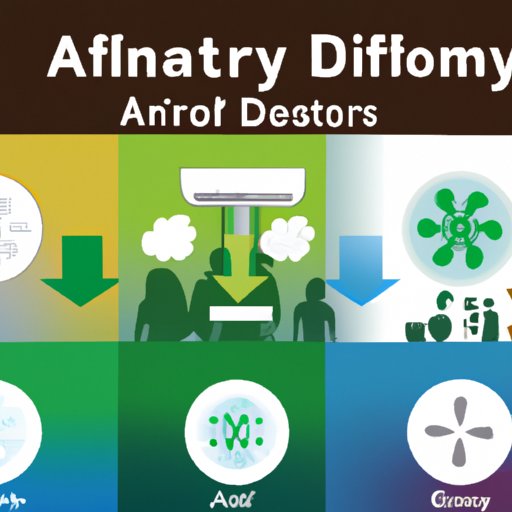Introduction
The air quality inside our homes has a significant impact on our health and wellbeing. Poor indoor air quality can cause a wide range of symptoms, from headaches and dizziness to respiratory problems and fatigue. In order to ensure good indoor air quality, it is important to identify and remove sources of indoor pollutants, ensure proper ventilation and airflow, install an air purification system, employ green cleaning practices, reduce humidity levels, maintain heating and cooling systems, and avoid the use of toxic chemicals.
Identifying and Removing Sources of Indoor Pollutants
Common sources of indoor air pollution include dust mites, pet dander, mold, bacteria, VOCs (volatile organic compounds), and outdoor pollutants that can enter through open windows or doors. To reduce the level of indoor pollutants, it is important to identify and remove sources of pollution. Steps to identify and remove sources of pollution include regularly vacuuming carpets and furniture, using an air purifier, washing bedding and curtains regularly, using a dehumidifier to reduce moisture levels, and sealing any cracks or openings in walls or floors.

Ensuring Proper Ventilation and Airflow
Proper ventilation and airflow are essential for good indoor air quality. Adequate ventilation helps to remove pollutants from the air and replenish it with fresh air from outside. Benefits of proper ventilation include improved air circulation, reduced odors, and improved energy efficiency. To ensure proper ventilation and airflow, consider installing a ventilation system, such as an exhaust fan in the kitchen or bathroom, or a window fan or air conditioner. Additionally, open windows and doors when possible to allow fresh air to circulate.
Installing an Air Purification System
Air purification systems can be used to reduce levels of airborne pollutants and allergens. There are several types of air purification systems available, including HEPA (high-efficiency particulate air) filters, activated carbon filters, and ultraviolet germicidal irradiation (UVGI) systems. Advantages of installing an air purification system include improved air quality, reduced odors, and improved energy efficiency. When selecting an air purification system, consider the size of the space, the type of pollutants present, and the desired level of filtration.
Employing Green Cleaning Practices
Green cleaning practices involve using natural, non-toxic cleaning products to reduce the level of pollution in the home. What is green cleaning? Green cleaning involves using natural ingredients such as baking soda, white vinegar, lemon juice, and essential oils to clean surfaces and eliminate odors. Benefits of green cleaning include improved air quality, reduced exposure to toxic chemicals, and cost savings. When cleaning, always wear gloves and a face mask to protect yourself from inhaling fumes.
Reducing Humidity Levels
High humidity levels can cause mold and mildew growth, which can lead to poor indoor air quality. The effects of high humidity include increased dust mite activity, musty odors, and the growth of bacteria and viruses. To reduce humidity levels, consider using a dehumidifier or running an exhaust fan in the bathroom or kitchen. Additionally, ensure that all areas of the home are properly ventilated and sealed to prevent moisture from entering.

Maintaining Heating and Cooling Systems
Regularly maintaining heating and cooling systems can help to improve indoor air quality. Benefits of maintaining HVAC systems include improved air quality, improved energy efficiency, and reduced risk of fire and carbon monoxide poisoning. Common maintenance tasks include checking and replacing air filters, inspecting ductwork for leaks, and cleaning coils and vents. Additionally, consider having your HVAC system professionally serviced at least once a year to ensure it is functioning properly.

Avoiding the Use of Toxic Chemicals
Toxic chemicals found in some household products can contribute to poor indoor air quality. Common household chemicals include bleach, ammonia, formaldehyde, and phthalates. To avoid the use of toxic chemicals, look for safer alternatives, such as natural cleaning products or homemade cleaners. Additionally, always read labels carefully and follow instructions when using chemical-based products.
Conclusion
Poor indoor air quality can have a negative impact on your health and comfort. To improve indoor air quality, it is important to identify and remove sources of pollutants, ensure proper ventilation and airflow, install an air purification system, employ green cleaning practices, reduce humidity levels, maintain heating and cooling systems, and avoid the use of toxic chemicals. With these tips, you can create a healthier and more comfortable home environment.


